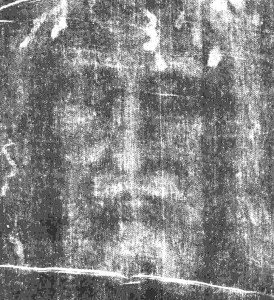Following some interesting off-blog email exchanges triggered by my recent post on the Knights Templar and the Turin Shroud, I’ve taken a fresh look at the evidence, and have a new suggestion…
The document that Barbara Frale turned up in 2003 appears to confirm a long-standing suspicion among a number of sindonologists (i.e. Shroud researchers, not people who study Donald Sinden) – that the Image of Edessa is the same thing as the Turin Shroud – and that it was secretly held & venerated by the Knights Templar between times (presumably giving rise to confused talk of kissing bearded idols, etc).
Just so you know, the Image of Edessa’s basic timeline looks like this…
- 525AD – 544AD: first appearance in Edessa – possibly hidden in a wall above a city gate
- 609: captured by the Sassanians
- 944: returned to Edessa and moved to Constantinople
- 1204: disappeared during the Sack of Constantinople
…whereas the Turin Shroud’s timeline looks like this…
- 1357: displayed in a church at Lirey by the widow of the knight Geoffroi de Charny
- 1390: Pope Clement VI allowed the shroud to be displayed
- 1418: the “Winding Sheet” entrusted to Humbert, Count de La Roche, Lord of Lirey
- 1452: given to the Duke of Savoy by Humbert’s widow Margaret
Yet there is something rather incongruous about the idea that the image on the shroud is actually of Jesus. Glen Claston points out (by email) that while early images depict Jesus much as you would expect Jews of the period to be depicted (i.e. short-haired, because nobody was allowed into temples with long hair), after 600AD images start to appear with long hair and a beard.

Glen’s understanding is that the only people at the time who had long hair were Nazirites (who took a vow not to shave their hair and abstain from grapes, wine and vinegar). In fact, probably because of the surfeit of “Da Vinci Code”-style novels and “H0ly Blood Holy Grail”-style books, the (formerly very marginal) issue of whether Jesus was a Nazirite has now become much debated.
(Incidentally, the most famous Old Testament Nazirite was Samson, which is why it was such a big deal to cut his “seven locks” – and modern Rastafarians have a creed which is apparently derived from the Nazirite vow, which is why they value herbs over alcohol. Hence one surprising issue with the Turin Shroud is whether the squiggles around the face [above] are actually proto-dreadlocks!)
That is, the culturally agreed image of Jesus started out as a mainstream Jew but around 600AD began to transform into something more like a Nazirite. But why should this be so?
My art historical suggestion (which has doubtless been made numerous times before, but what the hey, here it is again) is simply whether it was the appearance of the Image of Edessa in the sixth century which caused this change in the iconography of Jesus’ haircut. That is, rather than any subtle textual misunderstanding of “Nazarene” vs “Nazarite” (as is so often proposed), might it be that artists saw (or heard about) the ‘miraculous’ Image of Edessa and decided to use that as a visual basis for what Jesus looked like?
(Note that this is merely an hypothesis about the cultural reception of the Image of Edessa from 600AD onwards, rather than about any forensic / physical analysis of the object itself – it makes no difference whether the Shroud is genuinely miraculous or some 6th century craftsman’s subterfuge.)
Incidentally, one Turin Shroud-related issue that crops up again and again concerns the apparent height of the person wrapped in it: it is frequently asserted that this person would have been too tall to have been a Jew living two millennia ago. Yet what isn’t widely known is that there is a body of evidence that seems to imply that the Turin Shroud spent some time suspended on a kind of hanging wooden frame (probably for display in Edessa and Constantinople, it would now appear).
And so… why is the suggestion not then made that the herringbone linen of the Turin Shroud might simply have stretched lengthways under its own weight while being displayed? This might well have yielded a pervasive 10%-15% stretch, which (as I understand it) is broadly the kind of height difference in question. If you look once more at the face above, can you not see (as I do) an image that has been slightly vertically stretched? As a guide, here’s what it would look like at 85% of height:-

Turin Shroud, contrast-enhanced negative, 85% of height
Something to think about, anyway! 🙂
PS: as far as the haircut goes, I suspect that artists subsequently evolved Jesus’ haircut to a kind of worst-of-both-worlds middle-length trim – too long to be allowed in a Jewish temple, but too short to qualify as a proper Nazirite’s uncut hair. Might this be some kind of metaphor for the evolution of religion in general? I’m afraid you’ll have to work out your own moral narrative for this – I’m too busy looking at the evidence. 😉